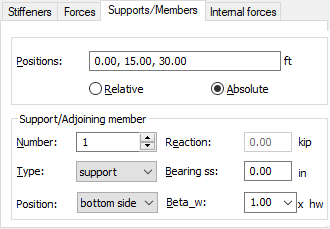Click the Support/Members tab in the Detailed analysis (steel member design) dialog top display the following dialog..

If a user-defined support is identified for the beam in question, the support will be automatically introduced into the list of supports and drawn in the graphical viewer. During calculations, the beam is verified, recognizing the information concerning the reactions in the support. (Note: The reaction is perpendicular to the longitudinal axis of the beam). For instance, for a beam with pinned supports and a concentrated force P applied at the center, the program will identify two support at beam ends and it will recognize the reaction value R = P/2 in its calculations.
If no supports are defined along the beam (for example; a spandrel beam in a gantry frame), a vertical member must adjoin the beam in question (a member that may potentially serve as a support). If there is an adjoining member, a support is suggested at this point. The value of the reaction transferred to such support will be calculated on the basis of the analysis of the shearing force at this point.
In all other cases, the position of supports at beam ends is suggested by default.
The places where there are adjoining (subordinate) beams, that transfer loads to the beam in question are automatically identified. During calculations, the force transferred by the member(s) is identified by analyzing the distribution of the shearing force over the beam in question. For instance, while analyzing a cantilever beam with the load P applied at its end, the force being transferred from a subordinate beam, the place where the force has been transferred is identified and the force P on the basis of the shearing force diagram is calculated.
A support and (an) adjoining member(s) do not both appear in one place. An exception is when the support is identified by the program on the basis of structure data. Neither can there be members at the beam top and bottom simultaneously.
By default, a support is located at the "bottom". It is assumed, however, that adjoining members transfer forces from the top. It is possible to delete a support or adjoining members.
If a concentrated force, originating in a reaction or an adjoining member, is not transmitted locally (at a point) to the beam, but it is applied over a certain length the length is defined in the Bearing ss field.
You can also define the buckling length coefficient for the analyzed web (Beta_w option). The coefficient is used to carry out the analysis of the ribbed web under the concentrated force in question or reaction (Verification / Web stability for compression). It is possible to select the most common buckling length coefficients from the list or to define a new value for the coefficient.